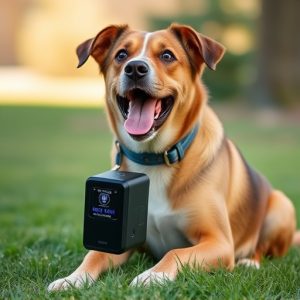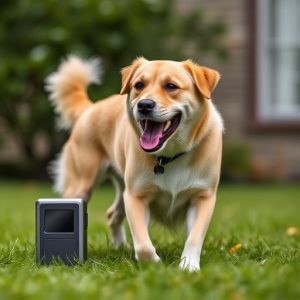Electronic Barking Dog Alarms: Comprehensive Guide to Safe Use
Electronic barking dog alarms offer a humane, innovative approach to home security. Mimicking dog ba…….
Electronic barking dog alarms offer a humane, innovative approach to home security. Mimicking dog barks, these devices deter intruders without causing distress, operated by motion sensors or other security features. They appeal to pet owners seeking a non-lethal solution for both security and pet behavior management, with options like ultrasonic waves or sound/shock technology. Responsible use involves combining positive training methods with strategic device deployment, avoiding harm to pets or sensitive individuals, under professional guidance.
“Uncover the world of electronic barking dog alarms—a modern solution for pet owners seeking effective, humane deterrents. This comprehensive guide explores the ins and outs of these innovative devices, from their advanced technology and working mechanisms to diverse applications and training considerations.
Learn how these alarms can benefit your household by addressing unwanted barking, ensuring safety, and promoting a peaceful environment. Discover the various types available and make an informed decision based on your unique needs.”
Understanding Electronic Barking Dog Alarms: A Comprehensive Overview
Electronic barking dog alarms are designed to mimic the sound of a dog’s bark, deterring potential intruders. These devices are a popular choice for homeowners seeking an effective yet humane alternative to traditional alarm systems. By emitting a realistic but artificial bark, they can alert owners of any unauthorized entry while avoiding the distress caused by real dog barks.
Comprending these alarms involves grasping their operation and advantages. They typically use recorded barks that are triggered by motion sensors or other security features. The sound is then amplified through speakers, creating a startling yet non-harmful noise that can startle intruders. This technology offers peace of mind, especially for those who love dogs but prefer not to have a real pet for security purposes.
How Do These Devices Work: The Technology Behind the Bark
Electronic barking dog alarms utilize advanced technology to mimic the sound of a dog’s bark, offering a deterrent for potential intruders. These devices typically employ a sensitive microphone that detects movement or vibrations, triggering a circuit that generates and amplifies the bark-like noise. The sound is often a high-pitched, sharp alarm that resembles a dog’s bark but lacks the physical presence of an actual canine.
The technology behind these alarms focuses on creating an effective yet humane deterrent. By reproducing the specific frequencies and characteristics of a dog’s bark, the electronic alarm captures attention without causing harm. This approach is particularly useful for homeowners seeking to protect their properties while also being mindful of animal welfare concerns compared to traditional, more aggressive alarm systems.
Benefits and Applications: When and Why You Might Need One
An electronic barking dog alarm offers numerous benefits for pet owners and homeowners alike. One of its primary applications is as a deterrent for potential intruders, emitting loud, realistic dog barks that can startle and alert anyone attempting unauthorized entry. This makes it an effective security measure, especially in areas with high crime rates or for individuals living alone.
These devices are versatile and can be used in various scenarios. For example, they can help keep unwanted animals like cats or stray dogs away from your property. Additionally, the electronic barking dog alarm can serve as a training tool for real dogs, teaching them to bark at appropriate times without excessive noise. It’s ideal for those seeking a non-lethal way to protect their homes and pets while also considering their neighbors’ peace.
Types of Electronic Barking Dog Alarms: Exploring Popular Options
Electronic barking dog alarms offer a wide array of options for pet owners looking to protect their homes and yards from unwanted visitors, all while managing their canine companion’s vocalizations. These devices generally fall into two main categories:
The first type uses ultrasonic sound waves that are inaudible to humans but irritating to dogs. They work by emitting a high-pitched frequency when triggered by motion or vibration, effectively scaring off potential intruders without causing harm. The second category employs a combination of sound and shock technology, emitting a loud bark-like noise followed by a mild electrical pulse. This method is designed to startle dogs and deter them from barking excessively, making it popular among those dealing with persistent barking issues. Each option has its advantages, catering to different needs and preferences in managing both pet behavior and home security.
Safety and Training Considerations: Ensuring Positive Use Cases
When using an electronic barking dog alarm, safety and responsible training are paramount. These devices should be employed as a last resort to address persistent barking issues, ensuring they do not become a source of distress or harm for pets or people. It’s crucial to follow best practices for positive reinforcement training alongside any electronic deterrent, such as clicker training or reward-based methods, to reinforce desired behaviors.
Pet owners should carefully consider the environment in which these alarms are used, avoiding areas where sensitive individuals like children or those with anxiety may be present. Regular monitoring and adjustments to the device settings are essential to prevent overstimulation or accidental activation. Additionally, consult with a professional trainer or behaviorist for guidance on effective training strategies tailored to your dog’s unique needs and temperament.


